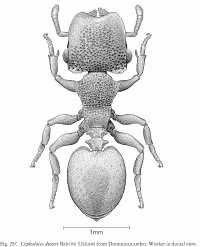Cephalotes dieteri
| †Cephalotes dieteri Temporal range: Burdigalian, Early Miocene Dominican amber, Dominican Republic | |
|---|---|

| |
| Scientific classification | |
| Kingdom: | Animalia |
| Phylum: | Arthropoda |
| Class: | Insecta |
| Order: | Hymenoptera |
| Family: | Formicidae |
| Subfamily: | Myrmicinae |
| Tribe: | Attini |
| Genus: | Cephalotes |
| Species: | †C. dieteri |
| Binomial name | |
| †Cephalotes dieteri Baroni Urbani, 1999 | |
One of a number of Cephalotes fossil species that are known from Dominican Amber.
Identification
A member of the coffeae clade differing from its sister species, Cephalotes integerrimus, by the denser foveae and by the CI < 114.0. (de Andrade and Baroni Urbani 1999)
Keys including this Species
Distribution
This taxon was described from Dominican amber, Dominican Republic (Burdigalian, Early Miocene).
Castes
Nomenclature
The following information is derived from Barry Bolton's Online Catalogue of the Ants of the World.
- †dieteri. †Cephalotes dieteri Baroni Urbani, in De Andrade & Baroni Urbani, 1999: 547, figs. 16A, 257 (w.) DOMINICAN AMBER (Dominican Republic, Miocene).
Unless otherwise noted the text for the remainder of this section is reported from the publication that includes the original description.
Description
Worker
Baroni Urbani (1999) - Head slightly broader than long. Frontal carinae with superficially crenulate margin. Vertexal angles truncate and with crenulate border. Vertex without denticles. Vertexal margin concave. Mandibles laterally angulate.
Mesonotum. Scapular angles visible in dorsal view. Pronotum with a narrow, long, continuous lamella. Promesonotal suture superficially impressed. Mesonotum unarmed. Propodeal suture impressed. Propodeum with differentiate basal and declivous faces; propodeal sides unarmed.
Petiole slightly narrower than the postpetiole. Anterior face of the petiole truncate; petiolar dorsum almost flat; petiolar sides with a small, pointed tooth. Postpetiole gently concave medially; postpetiolar sides anteriorly with a triangular tooth.
Gaster suboval and with a pair of anterolateral lamellae
Fore coxae angulate. Hind femora angulate. Mid and hind basitarsi flat and with slightly broad base.
Sculpture. Head minutely reticulate and with dense foveae, shallower on the anterior half. Ventral face of the head with sculpture similar to the one of the dorsum but with rarer and shallower foveae. Mesonotum reticulate and with larger and denser foveae than those on the head dorsum; the foveae smaller, shallower and rarer on the declivous face of the propodeum. Pleurae simply reticulate. Pedicel sculptured as the declivous face of the propodeum. Gaster and legs strongly reticulate.
Pilosity. Each fovea with an appressed canaliculate hair; similar hairs but not originating from foveae and thinner on the gaster and on the legs. Posterior borders of the distal gastral segments with rare clubbed hairs. Second gastral tergite with a pair of long, thin, pointed hairs.
Colour. Frontal carinae, vertexal angles, border of the pronotal lamellae and gastral lamellae lighter.
Measurements (in mm) and indices: TL 3.22-3.48; HL 0.80-0.88; HW 0.91-1.00; EL 0.23; PW 0.72-0.86; PeW 0.33-0.37; PpW 0.35-0.41 ; HBaL 0.29-0.30; HBaW 0.10-0.11; CI 113.6-113.7; PI 116.3-126.4; PPeI 218.2-232.4; PPpI 205.7-209.7; HBaI 34.5-36.7.
Type Material
Holotype and paratype workers in the Dominican amber sample Do-618 and Do-4162, both in the Staatliches Museum fur Naturkunde Stuttgart.
Etymology
This species is named after Dr. Dieter Schlee who built up the Stuttgart amber collection which represents the most important source of fossil material for this study.
References
- de Andrade, M. L.; Baroni Urbani, C. 1999. Diversity and adaptation in the ant genus Cephalotes, past and present. Stuttgarter Beitrage zur Naturkunde Series B (Geolgie and Palaontologie). 271:1-889. (page 547, figs. 16A, 257 worker described)


